

The magazine of the photo-essay

Dec 2017 back issue


“A free, really high quality photo-essay magazine. Fabulous!”
Stephen Fry. British actor, writer and film maker
by Jonathan Moller
“This book is dedicated to the people whose photos appear in its pages, and
to the memory of their family members who were disappeared, killed, or
massacred, and to all the other Peruvians who lost loved ones during the
internal armed conflict. Their pain and frustration are mine too, as is their
struggle for justice and truth, for a more just, peaceful, and equal Peru, with
human rights, respect, and dignity for everyone.”
Jonathan “Jonás” Moller

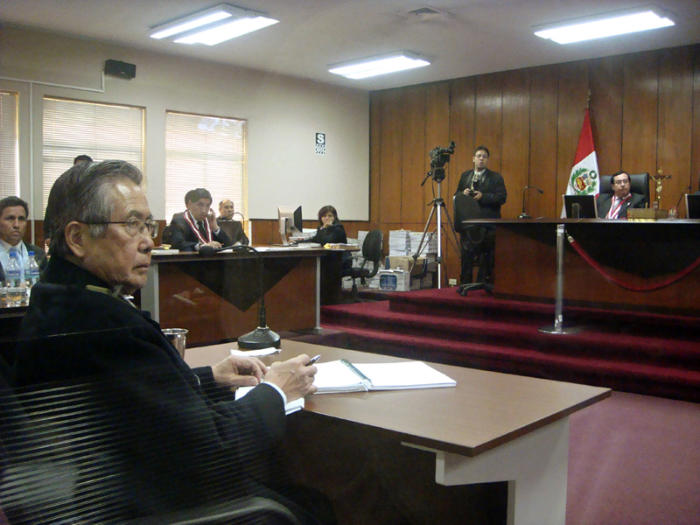
Peruvian ex-President Alberto Fujimori tried in Lima for violations of human rights, was president between 1990 and
2000, and extradited from Chile to Cuba in October 2007 to face charges of corruption and violation of human rights.
Already convicted on charges of corruption, he is on trial here for the massacre in Barrios Altos in November 1991 when
fourteen people were executed at an open-air party in the center of Lima, and for the La Cantuta massacre where nine
students and a professor were kidnapped from their dorms at the National University of Education Enrique Guzmán y
Valle - La Cantuta by the Grupo Colina, a death squad operated by the government. Afterwards, they were executed and
buried in secret on a desolate hill in the district of Cieneguilla in Lima. On April 7, 2009, nine months after I took this
photo, Fujimori was sentenced to twenty-five years in prison for the La Cantuta and Barrios Altos massacres. He is
concurrently serving three prison terms for other human rights violations, corruption and abuse of power. This is the first
time that the leader of a democratically elected government in Latin America has been declared guilty of violating human
rights in his own country. During his presidency, Fujimori adopted the National Security Doctrine drafted by the United
Sates, and implemented a strong arm as a tactic against the collaborators and militants of Shining Path and the guerrilla
Tupac Amaru regardless of whether they were suspects or actual members of those groups.
Lima, July 16, 2008.
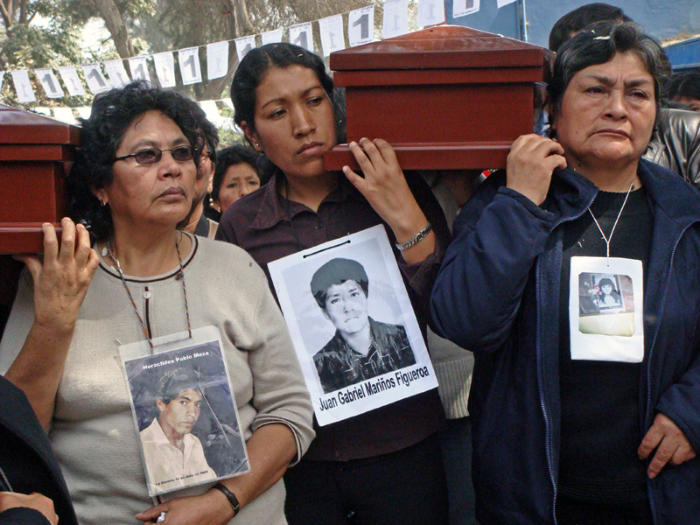
Participating in a commemorative march on the sixteenth anniversary of the La Cantuta massacre, the families of the
nine students and professor who were murdered carry coffins containing some of their remains. The ten were
kidnapped from their dorms at the National University of Education Enrique Guzmán y Valle - La Cantuta by Grupo
Colina, a death squad operated by the government, and were later executed and buried clandestinely in a desolate hill in
the district of Cieneguilla in Lima. The massacre took place during the presidency of Alberto Fujimori.
Lima, July 18, 2008.
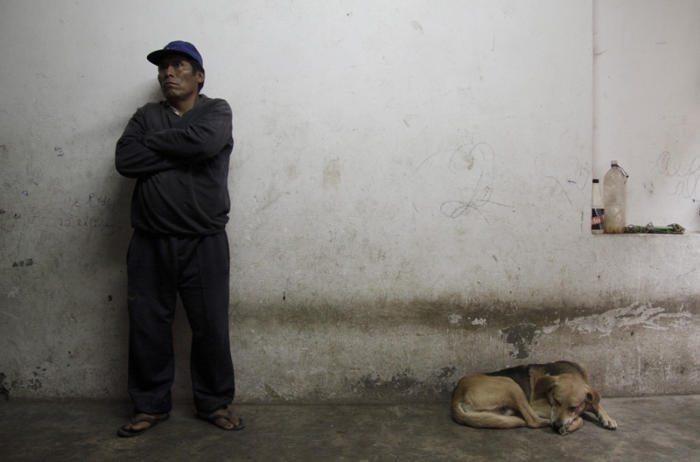
Julián Ricra Huamani shares his testimony on the violence of the 1980s in the Andes and the murder of the majority of
his family by the Armed Forces in the context of the government counterinsurgency against Shining Path. Fleeing from
the massacres and killings, he was internally displaced to the capital nearly twenty years ago. There he met his new wife
Teodora, and they, along with others, occupied these lands in the outskirts of Lima.
Pamplona Alta, Lima, 2009.
Remembering always my loved ones, always I am remembering. Up to now we still can’t; I think like this to not hurt myself but
always the bad dreams come. Sometimes I dream, I dream of violence…we all dream the same. Sometimes I’m a little more
calm but it always comes; we all dream the same.
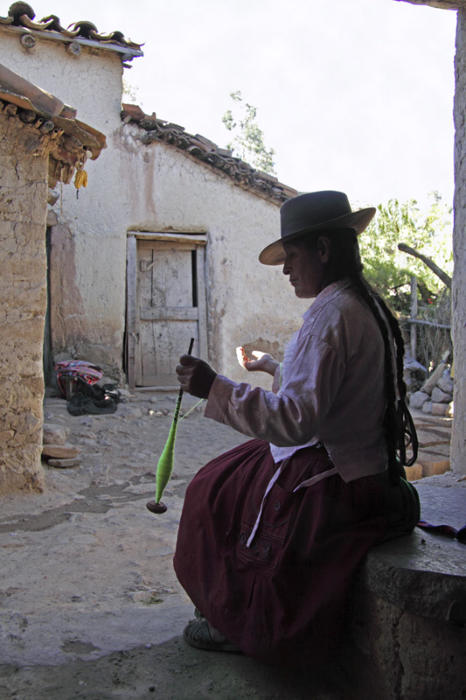
In this village in the Andes, Marina Allccaco spins wool in her home. Marina, an
indigenous Quechua woman, shared with us the tragic story of how her brother
was disappeared by soldiers from the Armed Forces in the 1980s during the war
against Shining Path.
Hualla, Region of Ayacucho, 2009.
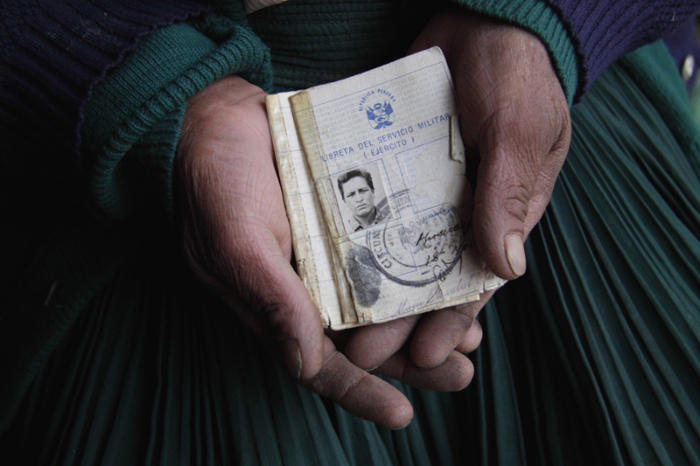
Juana Crisante de Méndez holds the military service handbook that belonged to her husband, Fortunato Méndez
Huamancusi. Fortunato was disappeared from the military base of Chimpapampa in Hualla in December 1984. Around
that time, a total of eleven people of Hualla were detained in the barracks of which eight are still classified as
disappeared. Between 1983 and 1984 more than fifty people from Hualla were taken to the Canaria military base (an
hour from Hualla) and were disappeared there.
Hualla, Region of Ayacucho, 2009.
I want to recover my husband’s remains. Before I was resigned, thinking that wherever he is, the dogs must have eaten him, but
now, no; I’d like to recover my husband’s remains.
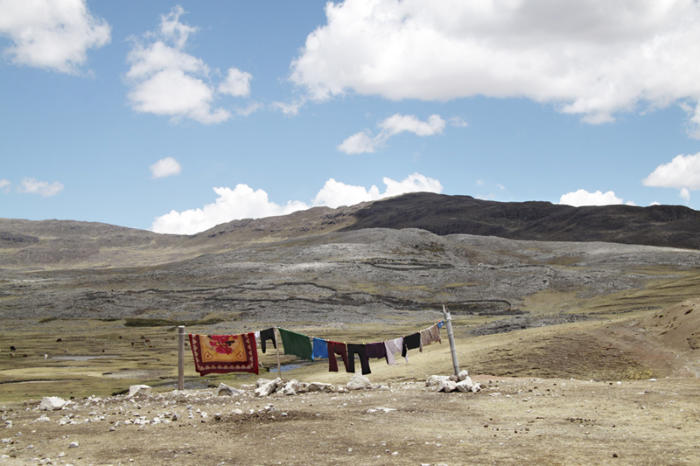
In the hamlet of Challhuamayo, located at an elevation over 4,300 meters in a remote zone of the Peruvian Andes, the
majority of the more or less thirty inhabitants herd llamas, alpacas and sheep. In the 1980s and 1990s this region was
devastated by violence during the brutal internal armed conflict between Shining Path and the Armed Forces.
Raccaya, Region of Ayacucho, 2009.
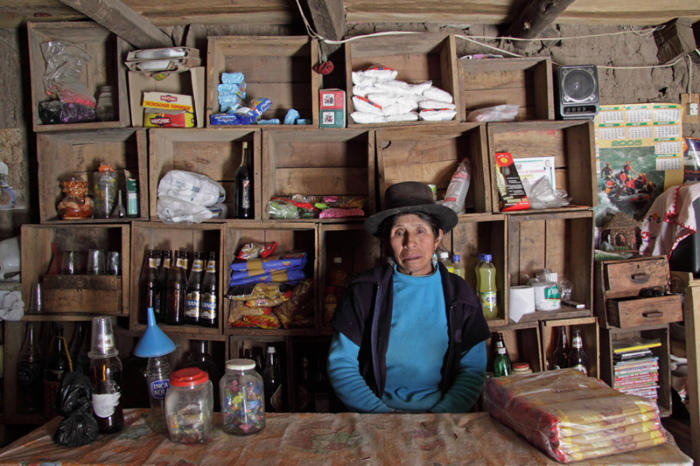
The husband of Emiliana Auccasi, Diomedes Cayampi, was disappeared by Shining Path in December 1990. She wants to
find the remains of her husband. Doña Emiliana is a member of the Association of Families of Victims of Political Violence
in Sacsamarca, a group of survivors who are pressuring the government to give them reparations and authorize
exhumations. She now is fifty-nine years old, lives alone, and works in her store.
Sacsamarca, Province of Huanca Sancos, Region of Ayacucho, 2011.
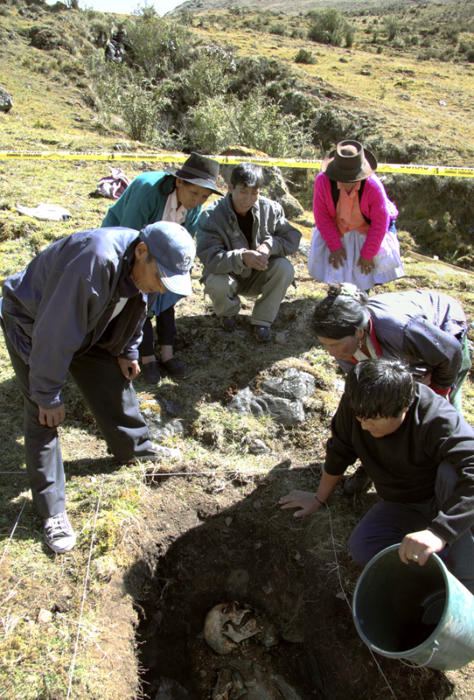
Relatives of the dead and a member of the Peruvian Forensic Anthropology Team
observe the exhumation of the remains of Teófilo Palomino Aguilar, one of seven
men who were murdered here by Shining Path at the end of 1984. According to
the testimonies of the survivors, the men were ronderos (members of the
Committee for Self-Defense) and were brutally murdered with knives, machetes
and axes.
Pucamarca, Province of la Mar, Region of Ayacucho, 2012.
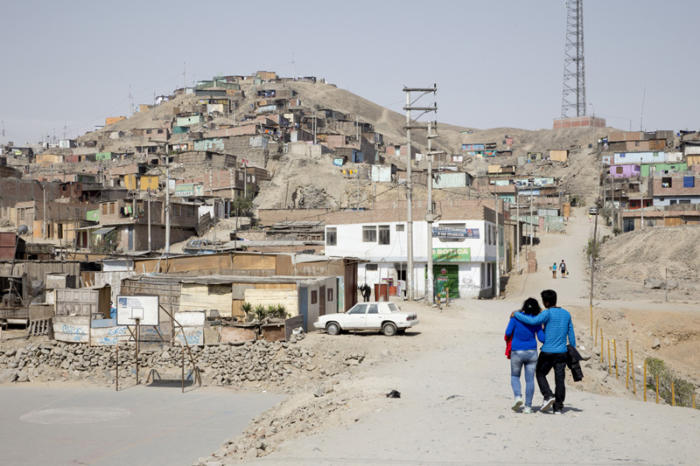
One of the sectors of the district of Manchay, in Lima, where there are currently 45,000 inhabitants. The majority of them
were displaced from the Andes, survivors of the violence and their children and grandchildren. People began arriving and
squatting on the land here at the end of the 1980s and start of the 1990s, mainly from the zone south of Ayacucho, and
especially from Hualla.
Manchay, Lima, 2013.
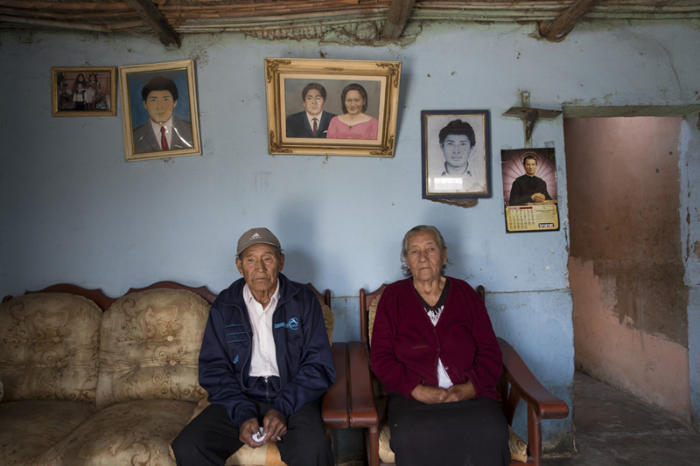
Alejandro Castillo and his wife Rosa Chávez de Castillo, parents of Denis Atilio Castillo Chávez. Denis was detained on
May 2, 1992 by the Grupo Colina, along with eight other men who were disappeared and murdered that night. On the
wall are two photos of Denis, one on each side of the photo of don Alejandro and doña Rosa when they were young.
Huanca, Santa, Region of Ancash, 2013.
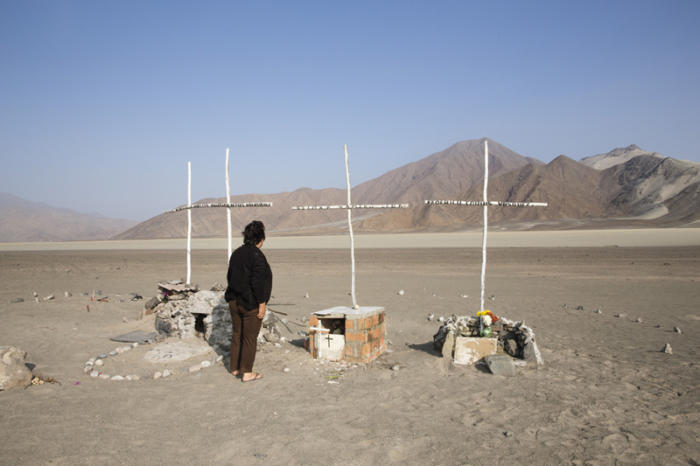
At the side of the highway Pan-American North, 22 kilometers north of Santa, Otilia León Velásquez, the sister of Gilmar
Ramiro León, contemplates the crosses marking the site where the remains of Gilmar and eight other men were found
and exhumed in 2011. They had been detained and disappeared in Santa on May 2, 1992. Gilmar was twenty-eight years
old and was on his bicycle the street that night when he saw a truck with armed and hooded men taking away two men
from the small rural neighborhood where he lived. Then, because he was a witness, he was also taken away.
Huanca Corral, Santa, Region of Ancash, 2013.
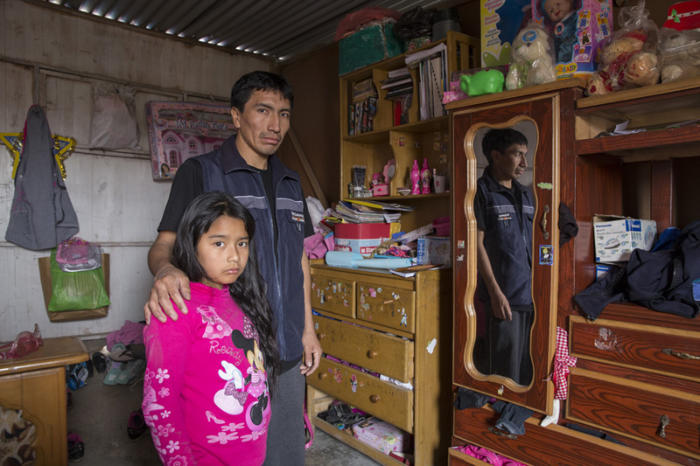
Reiner Ipurre and his daughter. Reiner’s father, Bernardo Ipurre Tacsi, was disappeared in December 1984 in Hualla in
the region of Ayacucho. Pamplona Alto, District of San Juan de Miraflores, Lima, 2013.
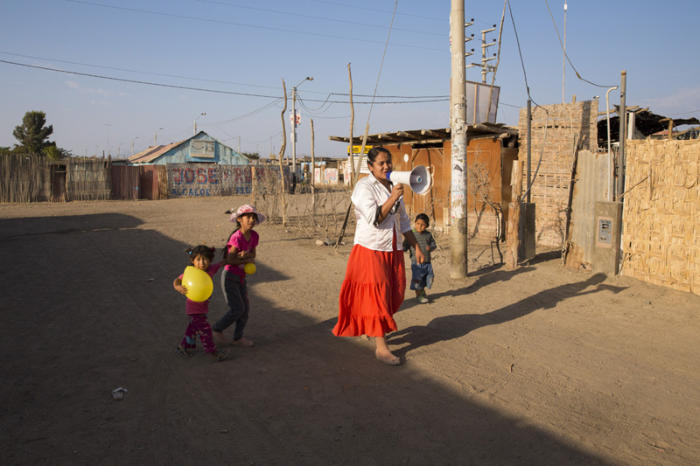
A woman who belongs to an evangelical church goes around the community calling out to children to come listen to
bible stories at the church. Santa Cruz de Villacuri is a community of displaced people from the Andes on the south coast
of Peru near the city of Ica. Santa Cruz de Villacuri, Ica, 2014.
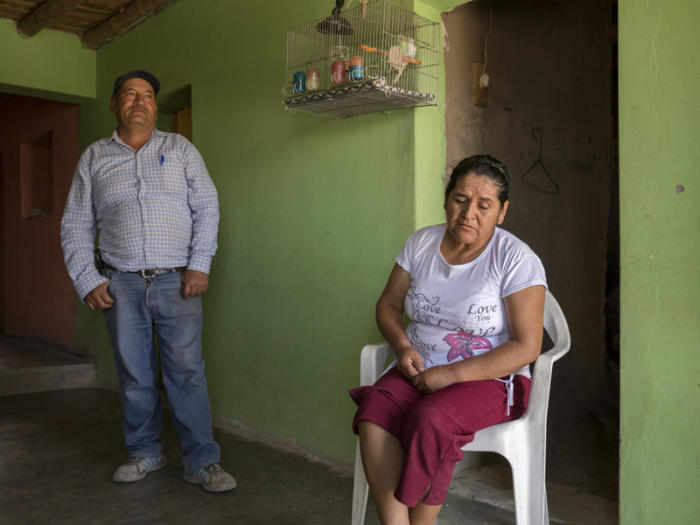
Floriano Guillen Ñaupa and his wife, Victoria Osno Illanes, remember how in 1986 soldiers detained and tortured
Floriano and another man; they hung them in a house for five minutes. Remembering what happened to her husband
and young son, Victoria weeps and begins to have a severe head ache. When the soldiers took her husband, Victoria with
her one and a half year-old son on her back, went after them. A soldier stopped her and pushed her with his arm; she
fell backwards with her son on her back. The boy was injured and died shortly thereafter.
San Francisco, annex of Ingenio, Region of Naxca. 2014.
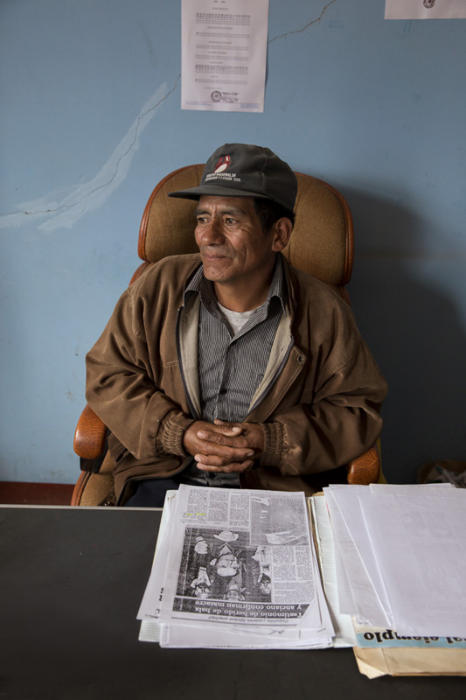
Ezequiel Baldeón at his office at the city hall in Accomarca with one of the
documents concerning the case of his parents. In January 1985, the military took
his father to a military base in Vilcashuamán; three days later, his mother went to
look for her husband at the base and the soldiers detained her. Ezequiel cries
when he tells us that he still doesn’t know what ultimately happened to his
parents. He was thirty-five when the military disappeared his parents. In 2006, he
filed a statement of denunciation, and since then there have been exhumations
at and near the base but the remains of his parents have not been found.
Accomarca, Province of Vilcas Huamán, Region of Ayacucho, 2014.
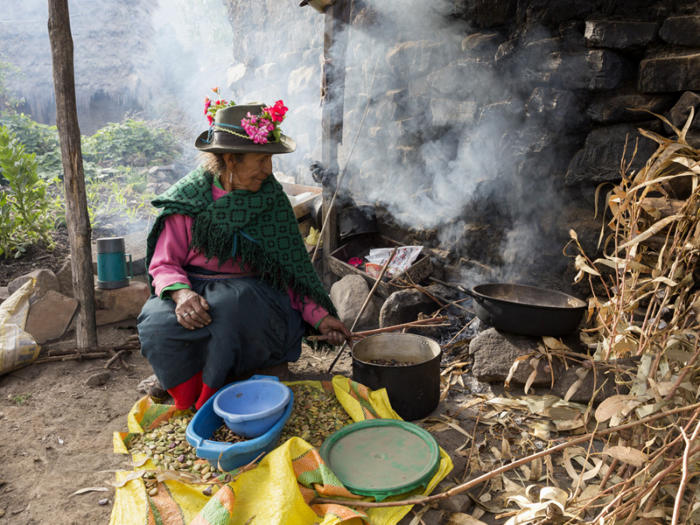
Sebastiana Vivanco prepares food in the kitchen outside her home. She lost her husband on July 1,1992. Members of
Shining Path entered the village; they arrived dressed as the military, gathered the population at the village plaza, and
asked them if they knew the two alleged subversives who had been captured. Those who said they knew them were
taken to the community auditorium, and tortured and then murdered with edged weapons such as axes, machetes and
knives. They hit the women, cut-off their braids, and forced them to prepare food. Among those murdered was Fabián
Pizarro Chaico, the husband of doña Sebastiana. Family members picked up the victim’s cadaver which was then buried
in the community cemetery.
Huamanquiquia, district of the Province of Victor Fajardo, Region of Ayacucho, 2014.
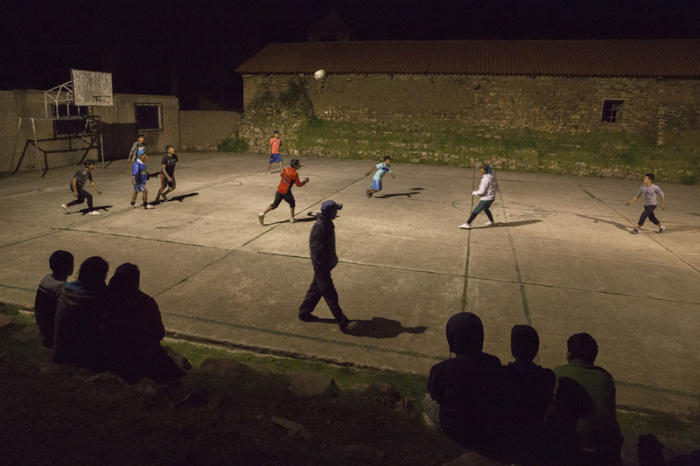
On most nights the young men of Huamanquiquia play soccer. Huamanquiquia, district of the Province of Víctor Fajardo,
Region of Ayacucho, 2014.











